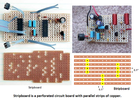All of the ones that I have from a name brand manufacturer (like Vishay) have tinned copper leads, as stated in the datasheet. And the leads have proper thickness. Steel/iron leads *are* cheap Chinese ones, distributed by many vendors.
What size resistors do you buy then? - the Vishay 0.6W ones I use have thin steel wires, why would you want thick wires on a small resistor?. There's also no mention of copper wires (or indeed steel ones) in the datasheet, but they stick to magnets. RS Pro resistors don't mention what the wires are in the datasheet either, but TE Connectivity claim to be copper wires.
Mostly I buy Vishay or TE Connectivity, or RS Pro if those aren't available - as far as I've noticed, every wire sticks to a slightly magnetised screwdriver, and it's really annoying
I'll have to see if I can locate any TE Connectivity ones, but they may be out of packets and in drawers/boxes.


